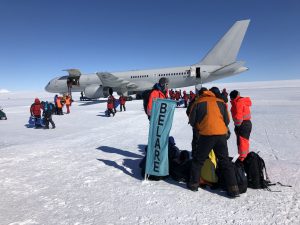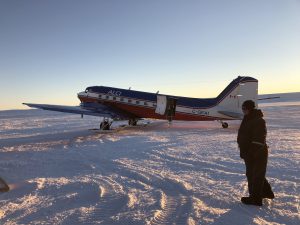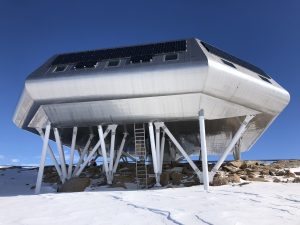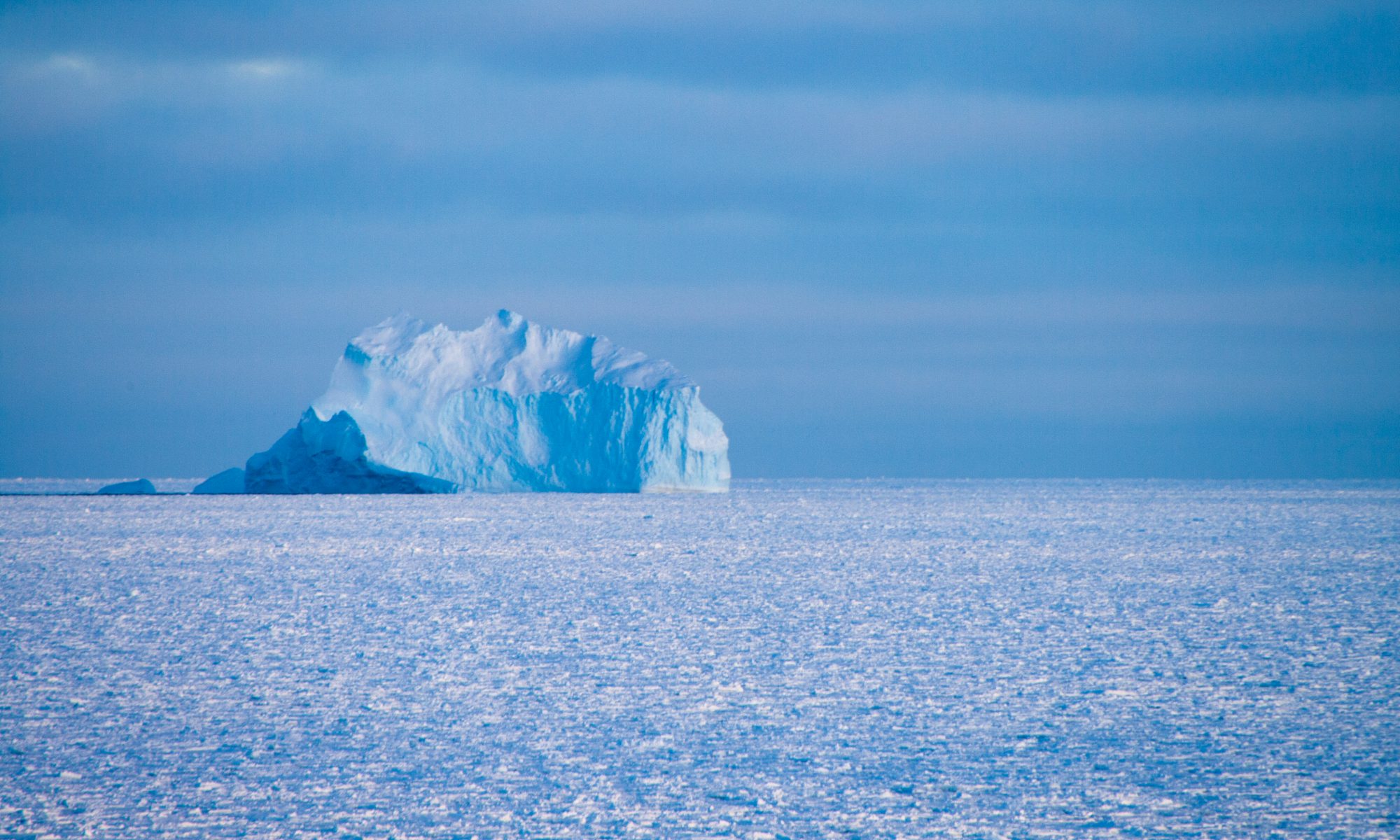The meteorite team arrived in Cape Town on January 5 but due to bad weather, the flight was delayed to arrive in Novo. Initially planned on Wednesday Jan.8, and after one missed attempt on Jan. 10 (the flight turned back half way!!), the team finally arrived at Princess Elisabeth Station on Monday 13 directly through the new landing field in Romnoes with the Ilyushin. They almost immediately left to the Nansen Ice Field, with nice weather conditions (like -30°c). The team is led by Steven Goderis (VUB), and composed of Hamed Pourkhorsandi (ULB), Naoki Shirai (Tokyo Metropolitan University, Japan) and Mehmet Yesiltas (Kirklareli University, Turkey). So far, 66 meteorites have been collected, including rare types such a carbonaceous chondrites and meteorites coming from asteroid Vesta. The weather had been bad for the last 3 days, with white-out conditions. Hopefully, the entire Nansen Blue Ice Field will be investigated this time. This is certainly not easy, with harsh weather conditions and the altitude of the plateau (3000m). Stay tuned for more pictures soon!!
51st Liège colloquium on ocean dynamics: Polar oceans facing changes

Place of the Conference: University of Liège – Place du XX-Août, 7 – 4000 Liège – Belgium
Polar oceans are facing profound changes. The Arctic Ocean and the waters west of the Antarctic Peninsula are at the forefront of global warming, while the rest of the polar oceans will face changes in the very near future. The changes to face are not limited to a raise in atmospheric temperature and modification in the freshwater budget. Increases of economic activities (shipping, tourism, fisheries and mineral extraction), contaminants and invasive species also put polar oceans at risk. Changes are already witnessed in terms of ice shelves volume, wind patterns and precipitation, sea ice extent, ocean circulation, ocean acidification and freshening, primary productivity, biodiversity and community structure or ecosystem functioning. As polar oceans are key components of the Earth system, changes there will have global impacts such as sea level rise, changes in low latitudes oceanic productivity, and oceanic CO2 uptake, among other ecosystem services.
The 51st Liège colloquium on ocean dynamics will address the observation and prediction of these changes and their consequences.
More specifically, the following topics will be covered:
- Measuring anthropogenic impact and pollutants. This spans from measurement of physical parameters, trace contaminants, inventory of climate related gases, micro plastics measurement, bio-indicators, monitoring economic activities
- Observing changes. Remote sensing is key to monitor sea ice and ice sheet shrinkage, ocean warming and freshening, changes in ocean circulation and environmental forcing. In parallel, several initiatives (e.g. AMAP, SOOS, SOCCOM, ASPeCt, ANTOS, INTAROS, SAON, CAFF, BEPSII among others) have developed to reinforce monitoring of the polar oceans and provide insights on current changes
- Assessing impacts. Anthropogenic forcing are impacting physical processes and biogeochemistry but also biodiversity and foodweb functioning. Tracking changes in an evolutionary perspective is challenging
- Specific cryosphere-oceans interaction. At the interface between land and polar oceans, ocean interactions with ice sheets and sea ice are key in controlling ice-sheet balance, sea level rise and water mass transformation rates
- Enlarge our temporal perspective: paleo-oceanographic changes. Ocean sediment records provide paleoclimate proxy indicators of past changes. These benchmarks allow a better grasp on current changes in term of level, significance and rapidity
- Predicting future changes. Modeling is a major tool to understand past and present changes and to predict future changes from a local to a global perspective. More specifically, simple ocean model, ice sheet or sea ice- ocean coupled model, biogeochemical model, dynamic energy budget, species/trait distribution model among others are well suited to investigate changes in polar oceans.
- Teleconnection and global perspective. As a result of the teleconnection of polar oceans to the global ocean, changes in polar oceans can propagate more globally. Assessing such impacts is critical to understand actual and future changes of the global ocean
- Mitigation. Several tools can be used to mitigate or limit the impact of some anthropogenic pressures: enforcement of conservation measures, marine protected areas, sewage treatment, education and awareness raising that need to be further developed to tackle polar ocean changes.
Special sessions on dedicated projects are welcome.
Papers dealing with the above-described subject are welcome and will be published in a special issue.Further details (submission, registration, deadlines, venue, …) are available on the web site : http://labos.ulg.ac.be/gher/home/ /
/
Deadline: Submission of abstracts – 1st March 2019
December 10 – 15, 2018: The Last Traverse.
5 Days, 490 Km travelled with the Hilux, 3 sampling sites visited, and our mission has finished.. Happiness of all we have done and achieved in this short stay in Antarctica but a bitter flavor at the same time.
Day 1 -December 10: 15 hrs trip travelling in Caravan to the waypoint where we will settle the camp shared with the glaciologist group from Belgium. Yes, it was a very exhausting, long and a very very slow drive (9km/h). But as you can see on the pictures: we were taking a lot of equipment. We arrived at destination 1:00 AM in the morning, all thrilled, sleepy and hungry. So, in less than 15 minutes the field guides settled up 8 tents to sleep in groups of 2. Usually you will have your own tent, but the tiredness is so much that for the moment nobody complains. We all just need some rest. By the time we went to bed it was already pass 2 AM and the alarm for the next morning is in 5 hrs.
Day 2 – December 11: After only 5 hrs of sleep, the faces in the Kabobs Kitchen are not the friendliest ones. 😉 but we managed to have a nice breakfast. We are so many that we even need to take turns to eat or whatever we want to do in the kitchen. So, to keep everybody happy, organization is the key in here. The plan for us is to reach our next sampling site: ~35Km in the coast direction. With the Hilux, this might take up to 4 hrs. After a couple of technical issues with the Toyota and more than 6 hrs since we left camp, we can see from the distance 3 bright little things, the dust collectors, shinning like diamonds in the sky! The landscape around is just breath-taking. We can see the ocean from here! The mix of colors is beautiful; the clear blue of the sky hidden in the white clouds, the dark blue of the ocean with the icebergs floating in the distance and the ultra-bright white snow is just incredible.
One more day has passed. We are back to camp. It is late, almost midnight. Everybody is asleep. Silent is the owner of this place. The only thing you can hear is the wind blowing against the tents. Off to bed I am!
Day 3 – December 12: Waypoints already in the GPS, it is time to go. This is the furthest place (sampling site) we will go. We have a long day ahead us.
This is another new place where we have to set up our dust sampling systems. With this new site, we now have a total of 7 sampling points across a 230 Km transect. Congratulations for us! Record on time. In less than 3 hrs we have finished, and we are ready to make our way back to camp. No rush, it is still early so if we can make it by dinner, we are all happy.
Day 4 – December 13: Last sampling station to visit and we are done! It’s only 15 Km away from the base camp. A piece of cake! Except the visibility is 0. Driving blind in a white out in Antarctica is not easy. Not fun either, so you better stick your eyeballs to the window and try to find the old tracks in the terrain to make this final traverse enjoyable. Good luck with that and an extra beer tonight for the first who is able to see it! And don’t forget to hold you tight or scream loudly “depression up front!” if you don’t want your head to be smash in the roof of the Hilux.
Now the tricky part. How we will be able to see the poles? Usually we always stop 300 m before the waypoint to avoid contamination but in the middle of the white out that is definitively a challenge. But we are team and as in any other, we have a goal, so splitting tasks to maximize our search. We decided, one will focus the view on the front. Other to the left and the other one to the right. After an intensive search, Bingo! They there are! 🙂 Wind is blowing hard, so let’s hurry before our fingers freeze.
Back in base, soup and a half-frozen sandwich for this late lunch is what we have. And not relax or get comfy too much because we still need to organize and load the truck for the 10 hrs. return trip to the station tomorrow.
Day 5 – December 14: 6 AM in the morning alarm off! get up get up, we gotta go! Last breakfast with some of the glaciologists who are already up. Next thing to do, undo the tents. Well in reality the first thing is to dig out the tent from the huge snow pack accumulated during the night with the wind. After 3hrs of work and preparation and wrapping the Zarges boxes with all the equipment on the Hilux, now is official… we are leaving … I don’t like to say goodbye, but we leave the glaciologist camp very thankful to everybody! All the best for the rest of your mission folks! 8 hrs later and a very bumpy and bouncy trip, we are home again! And the welcome for us is with pizza and beers. Thank you to the ones we prepared this delicious meal from scratch!
And if you want to know the end of this wonderful adventure, read the next blog in a few days…
Stefania Gili.
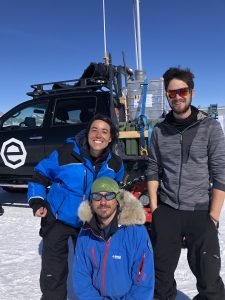
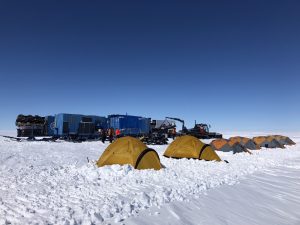
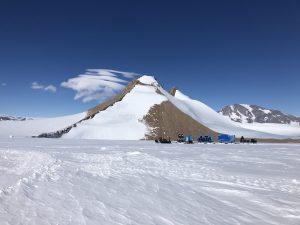
December 5, 2018: Romnoes and the beauty of the Blue Ice
After a previous failed mission to Romnoes, today seems to be the day for! So, here we go, second chance for us. Total Travel Distance: 125 Km. Estimated Time: 9 hrs. Vehicle: Skidoo.
Henri (Station’s Assistant Manager) is waiting for us outside to record and capture in pictures our departure. “All the best folks” he said, while we slowly left the station.
After a long period of bumps on the skidoo, the discover of blue ice was just fantastic! When driving in Antarctica there are certain rules. You always should drive in one line, keeping a prudence distance from each other and checking behind for the rest of crew. The order was always Manu opening in the front, me in the middle and Preben closing the line. But well like any other law, I suppose there is always an exception, right? Suddenly, I lost Preben. He was not behind me anymore … he was there, somewhere enjoying the drive on the blue ice like he was in a rally car race! He had so much fun! Me, forget it. I don’t have the skills. I was just too focused not to slide or turn over the skidoo, because there are not stable as they look like.
After the “blue race” on the ice we reached our site. The weather is almost like beach weather for Antarctica. Pretty warm, so very nice to do our job. Everything went according to the plan. Samples recovered, replaced by new ones and once again we are done!
Time to come back home. In our way back, Alain, the manager of the station called on the radio and invited us to make a quick stop at Perseus. A new site where part of the construction station’s team is working for a future airplane landing area. It is quite impressive to see these huge machines and trucks removing snow from one side to another and building things in such in hospital place.
Thankfully for the visit and the warm welcoming coffee we must continue; PEA is 60 Km away. It is already the afternoon, so better keep moving if we want to be on time for dinner!
A couple hours later… 7:55 PM, just 5 minutes before Christine’s bell rings to announce dinner, we arrived sound and safe! No time for clean up or organize the stuff we brought back from the field … it’s time to run upstairs, grab a plate and wait in queue before the food is gone! We are more than 30 people now, so rather be the first than the last one! Digestive tea after the delicious Lasagna and off to bed we go because in two days the greatest traverse of this mission is coming.
More stories in the next blog,
Stefania.
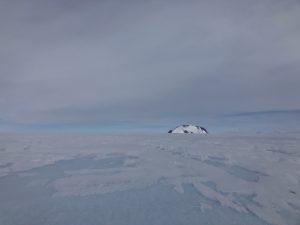
Nov. 30 2018: The Freezing Traverse to the Plateau
After being on the Antarctic Plateau, I promise I won’t complain about cold anymore.
9 AM UTC Time, the Hilux fully loaded with the necessary stuff and not 3, but 4 Musketeers ready for the next adventure! 65 km to our final destination. On a regular route you will probably cover this distance in less than an hour. In Antarctica, 4 hrs. We can’t go more than 15 Km/Hr. Skidoos are faster, but we are not warm, we can’t talk, and for sure they are not that comfy. So, well the “slow motion” is worthy then. Around 1:30 pm we reached the first sampling site. -18C. Cold, of course, but not bad. With the help of Henri and Manu, we get to work. We can’t spend too much time here because we still have a new sampling site to go to. It’s only 16 Km away from this one, which means ~1 Hr driving if we are lucky and the terrain is in good condition.
After almost 2 hours, we’re done here, and we begin our trip to the next point: The Deep Plateau. The landscape is just incredible, and the more we drive the more I notice and feel the difference. Katabatic winds blowing harder, temperature decreasing pretty fast to ~-23°C and voila! here we are, in the middle of nowhere. To the side, you turn your head and look at the most beautiful flat, white and bright 360 panorama you can ever imagine.
Before getting out of the car, two very important things. Number one: organization of all the tasks to do. Each of us is responsible for doing something different. That way we can achieve the goal efficiently but quickly due to the low temperatures. Number two: (but this one is just for me) to be ready with the “ultraclean outfit” in order to minimize the contamination of the samples as much as possible. Being aware of the chilly temperature, hand warmers are in between my two gloves, but I was not prepared to be blasted by the wind! In a matter of seconds my vinyl gloves were completely frozen and, with that, my fingers as well; the -23°C feels like -30°C! So, I ran to the Hilux to take the gloves out and replace them with regular plastic gloves. I am sorry for science in this point. But if I lose my fingers now I won’t be able to complete my mission in Antarctica and so far, we only have 3 out of 7 sites done! Safety first.
While I’m sampling snow, my folks are installing the three new poles we need at this new site. Two for the organic compounds and one for the inorganic materials. We all finished almost at the same time. So, either I took a long time for the sampling or they did their job very fast. 6:30 PM and we’re finally done, high fives for the 4 of us. Nice freezing job! But the satisfaction of seeing our samplers set up is a great feeling. It’s not easy to work in extreme conditions but always possible when even the small details were triple-checked before going. After another 4 ½ hours we’re back home. Princess Elisabeth station is so quiet because it’s almost midnight and the whole crew, except us, is asleep. Christine has left 4 plates ready with dinner for us on the counter in the kitchen. That was so nice of her.
And that is how our traverse ended. Full tummies, happy hearts! Goodnight everybody. 😉
Until the next blog.
Stefania
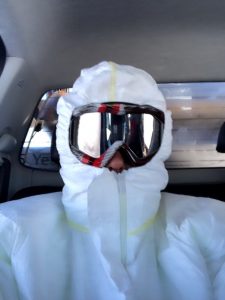
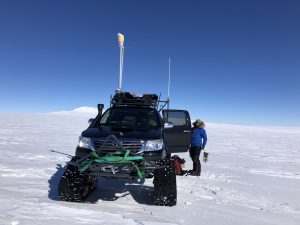
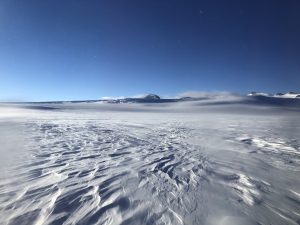
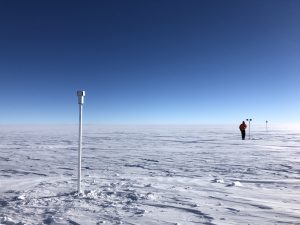
Nov. 28 2018: The Bad Guy: The Antarctic Weather
Unpredictable, changeable, variable, unstable. All in one. But seriously how bad it could be? Well, pretty bad indeed. Awful and very frustrating.
I cannot even mention how many times these past days Preben and I were ready to go, but literally ready, and at the last minute a new forecast changes everything. So far, we have three missions aborted, and one of them we were so close, only 12 Km away but unfortunately, we had to come back. The combination of strong winds and not an easy terrain make us to return for safety. Anyway, we came back safe and sound to the station, without samples and not with a smiling face. The lesson to be learned: working on this kind of environments requires extra patience! And never giving up…
The morning of Tuesday November 27th, was so much productive for us. Not because the weather was good but because we managed to finish the installation of 3 active pumps, for both organic and inorganic compounds. Preben came up with a very smart idea to improve the inlet of my active pump and after seeing the new modification installed on the roof of the “Atmos shelter”, our little and cozy “office” for the next weeks, we are very happy with the results! So now the smile is back in our faces!
Wednesday is the day of preparation for our, hopefully, next field trip to the Plateau. A traverse of ~75 Km to be done in the Hilux for safety reasons. We have two sampling sites to visit. One from the previous season and a new site in a more challenging area in the deep Plateau to increase the resolution of our sampling. We are very excited to complete this traverse so I’ll tell you more in the next blog.
Cheers to all the readers,
Stefania.
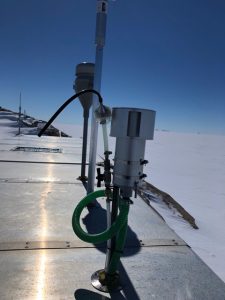
Nov. 22, 2018: Doing Science is always Fun!
Thursday, November 22st, sledge attached to the skidoo, Zarges boxes loaded with all the required material to work on field, and coordinates on our GPS, Preben, Henry (the chief scientist) and me are ready to go 4 Km away from Princess Elisabeth Station.
3, 2, 1.. Let’s do it! 20 minutes later we arrive onsite and from the distance we can see our poles standing. YES. Nice feeling, we found everything as expected. We parked the skydoos few meters behind the site in order to avoid contamination. To continue protecting our samples as much as possible, it’s time for me to dress up a little bit. And yes, you can laugh, with the wind blowing and inflating my uniform I look like an astronaut! Two different kinds of samples I have to take care of. First, I’m gonna collect snow samples into a pre-cleaned 10L bottle that will remain frozen upon return to our lab in Brussels. Second, I’m going to replace the filters from the passive dust collectors known as Sigma2 placed by Nadine during the previous season (1-year sampling period). While Preben is taking care of his organic collectors I am dealing with mine, and Henry is helping us with whatever we need and is the named photographer ;).
After almost 2 hours we are done! We are very happy of our work, so we came back to the station to store the samples in the freezer and re-organize everything until the next field trip that will depend, of course, as everything in Antarctica, on the weather!
Tefi
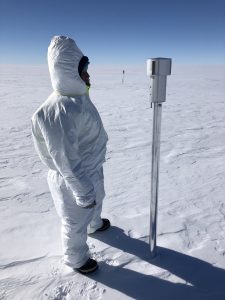
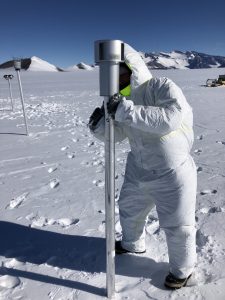
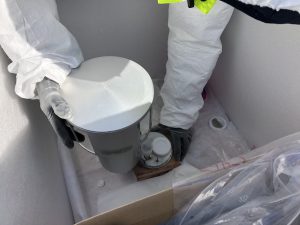
Nov. 19/21: Staying Alive and much more
“Ah, ha, ha, ha, stayin’ alive, stayin’ alive
Ah, ha, ha, ha, stayin’ alive…”
That is not only a Bee Gees song. It’s also the same tempo of 100 beats per minutes at which one should give chest compressions during CPR. What do we know about Hypothermia?? Five different stages and trust me after the talk, you don’t want to experience none of them! Thank you so much Dr. Sandra for your great training and advices! These past days were full of very important and valuable lessons. We learned a lot. Briefly, when you are in the field you are not alone, you are responsible not only for yourself but also for the rest of team.
After such important classes it looks like we are ready to start doing some real work. With the skydoos warm up, it is time for me and Preben to start taking care of some stuff located in the “Atmos shelter”. Here Preben has a High Volume Sampler and I have an Active pump. Both samplers are designed to collect atmospheric particles but the kind of filters we use and scientific goals we look at are different. I focus in the inorganic composition and he looks at the organic compounds. At the same time, in this shelter there are also a couple of instruments from some of our colleagues who are not here this year. That means we were trained before to take care of these devices. Preben is really good managing everything and extremely precise and organized doing his work. So, I can’t complain. I help him with what he needs and learn a lot indeed. So far, I think we are doing a great team.
In the next days we will go to the field to check our sampling sites from last year. So for more news keep reading the next blogs…
Nov 17/18, 2018: Arrival at the Princess Elisabeth Antarctica Station.
It is time to give you news… how our adventure continues… 1 am in the morning and we finally arrived to PEA (Princess Elisabeth Antarctica Station, the Belgian Station). What a great feeling! Alain Hubert and other members of the team are waiting for us. They welcome us very kindly and give us the first indications and rules about how everything works here. After a cup of warm tea, it is time to rest a little bit. 7:30 am we need to be back for our first official meeting and meet the rest of the crew. Tired and jetlagged or excited or with a combination of everything, we make our way to our bedroom. It is a blue container outside the station that will shelter us for the next 5 weeks. In case you are wondering, it is heated, of course! The morning of Saturday November 17th, after breakfast, Alain Hubert (the famous Belgian explorer and chief in charge of the Station) gave us a tour showing us the entire station, explaining in detail about the management and functionality of PEA. I must to say, it is incredible what they have built so far. It is a place with all the facilities you can imagine and a completely zero emission station is the goal for the next coming years. Water Engineers, Electricians, plumbers, constructors, technicians, etc… are part of the crew responsible every day of the running of PEA but we all have duties that help for the right development. I feel very delighted to be part of this, at least this year. The day is almost over and everybody is excited because Sunday is day off! So now it is time to enjoy dinner and some beers and/or wine all together.
It is Sunday already and we cannot wait to go outside and explore the surroundings of PEA a little bit. Always following the field guides, they take us for a tour to the “wind scoop” of the Utsteinen mountains. We are six and for me is the first time walking in the ice using crampons. Landscape is incredible beautiful. Shapes I’ve never seen before and also sounds I’ve never heard or experienced. My eyes are just amazed for what I am seeing. I am so lucky to be here, that’s all I can think of. So, in resume, it was a wonderful experience but I couldn’t have done it without help. So, thank you Daniel (one of the field guides)! For someone without experience like me, support is very important.
The next two days will be training days for us. This means medical, GPS, skidoo driving, crevasse safety, rescue, etc. So if you are interested to see how this goes, more stories later on….
Tefi & Preben.
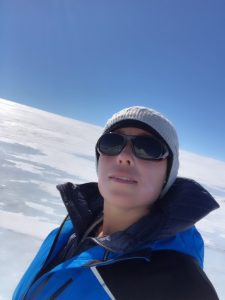
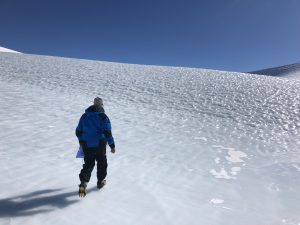
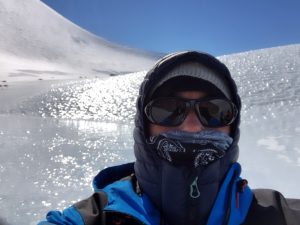
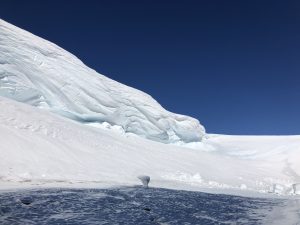
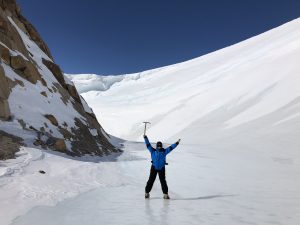
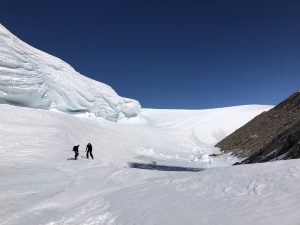
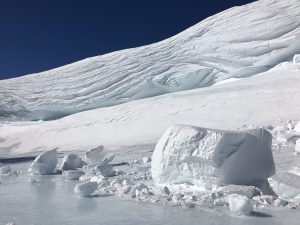
Nov 16 2018: The Beauty of the indescribable -Antarctica Day 1.
The CHASE expedition Nov.-Dec. 2018 –
The adventure of Stefania Gili (ULB- Labo. G-Time) and Preben Van Overmeiren (UGent – Department of Green Chemistry and Technology)
After several months of preparation, finally the time has come. Mixing of feelings to hear “Ladies and Gentlemen, please it’s time to get ready with your warm clothes. We’ll be landing shortly…” Minutes later after a warm clapping for the genius pilot who landed us safe, the steward said “Welcome everybody to Novo Air Base, Antarctica, Local Time is 1:00 PM.” The Boeing 757 opens its door and here we are, the BELARE /CHASE team has completed the first leg of this trip to Princess Elisabeth Station. Oh yeah ! Happy faces, at least for the ones who are the first time here! Beautiful weather today! We couldn’t ask for more to be honest. While part of the team is checking that our cargo has arrived complete and safe, the rest is taken to a “container house” to wait until the departure of our next flight, which is at 9:00 PM local time. After a great welcoming at Novo, especially for me because the Argentinean team (16 people) gave me some goodies to bring with me! That really made my day even more exciting because it was a nice surprise I was not expecting. Seated now in a smaller plane, we are ready to flight to put new home for the next 5-6 weeks. The feeling is just amazing. After 1 hr and 45 minutes we finally got the the view of the PEA !!! Unbelievable, we are here !
If you want to know what is next … read the next story …
PS: I hope you enjoy the pics as much I do …
Tefi & Preben.
